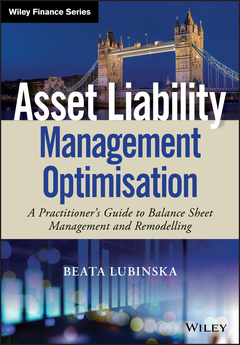Description
Asset Liability Management Optimisation
A Practitioner's Guide to Balance Sheet Management and Remodelling
Wiley Finance Series
Author: Lubinska Beata
Language: English
Subject for Asset Liability Management Optimisation:
240 p. · 17x24.6 cm · Hardback
Description
/li>Contents
/li>Biography
/li>
An advanced method for financial institutions to optimize Asset Liability Management for maximized return and minimized risk
Financial institutions today are facing daunting regulatory and economic challenges. As they manage bank regulation and competition, institutions are also optimizing their Asset Liability Management (ALM) operations. The function of the ALM unit today goes beyond risk management related to the banking book into managing regulatory capital and positioning the balance sheet to maximize profit. Asset Liability Management Optimization: A Practitioner's Guide to Balance Sheet Management and Remodelling offers a step-by-step process for modeling and reshaping a bank's balance sheet. Based on the author's extensive research, it describes how to apply a quantifiable optimization method to help maximize asset return and minimize funding cost in the banking book.
ALM ranks as a key component of any financial institution's overall operating strategy. Now, financial professionals can use an advanced solution for optimizing ALM. This book takes a closer look at the evolving role of the ALM function and the target position of the banking book. It provides strategies for active management, structuring, and hedging of a bank balance sheet, while also exploring additional topics related to ALM.
- A description of the Funds Transfer Pricing (FTP) process related to a bank?s target position
- Detailed examinations of interest rate risk in the banking book (IRRBB)
- Discussion of Basel III regulatory requirements and maturity gap analysis
- Overview of customer behavior, along with its impact on interest rate and liquidity risk
- Practical spreadsheet models (NII sensitivity and EVE volatility IRRBB model, simplified optimization model for minimization of average funding cost for a bank and an example of behavioral model for Non-Maturing Deposits)
- Explorations of model risk, sensitivity analysis, and case studies
The optimization techniques found in Asset Liability Management Optimization can prove vital to financial professionals who are tasked with maximizing asset return and reducing funding costs as a critical part of business objectives.
Foreword ix
About the Author xi
Introduction xiii
Chapter 1 ALM of the Banking Book 1
The Role of Asset Liability Management in Commercial Banks 1
Overview of Financial Risks Existing in the Banking Book 7
Regulatory Requirements – Basel III 13
Capital Requirements According to Basel III/CRD IV 17
Selective Review of the Literature Related to ALM and Integrated Management of the Interest Rate Risk and Liquidity Risk in Commercial Banks 19
Chapter 2 Methods of Measurement and Management of the Interest Rate Risk and Liquidity Risk 23
Interest Rate Risk in the Banking Book – Measurement and Management 24
Exposure to Short-Term Interest Rate Risk – Maturity Gap Analysis 24
Maturity Gap Analysis from the Economic Value Perspective 33
Liquidity Risk in the Banking Book – Measurement and Management 41
Short-Term Liquidity Management Principles 45
Medium Long-Term Liquidity – The Principles of Structural Liquidity Management 46
The Role of Funds Transfer Pricing in Banks 50
Pricing of Different Products in the Banking Book 54
Behaviouralisation Concept in FTP 57
Chapter 3 Customer Behaviour and Its Impact on Interest Rate and Liquidity Risk 61
Significance and Impact of Behavioural Issues in the Banking Book 61
Modelling of Customers’ Deposits – Liabilities Side 63
Balance Sensitivity Modelling 68
Modelling of Loans with Early Redemption Optionality –Assets Side 70
Statistical Prepayments 70
Financial Prepayments 71
Chapter 4 Formulation of the Optimisation Process and Articulation of the Decision Model 73
The Optimisation Method Applied to the Banking Book 74
Introduction of the Optimisation Concept 75
Definition of the Initial Banking Book Profile 79
Building the Objective and Constraint Functions in the Optimisation Process 81
The Importance of Model Sensitivity Analysis 96
Definition of the Sensitivity Parameters for the Optimisation Model 98
‘Significant Changes in Interest Rates’ Scenario 98
Changes in the Initial Proportions of the Asset Base 100
Changes in the Output of the Deposit Characterisation Model – Balance Volatility, Balance Sensitivity, and Average Life of the Product 100
Introduction of the CPR into the Model 100
Chapter 5 Practical Example of the Optimisation Process and Quantification of the Economic Impact under Base and Stress Scenarios 101
Case Study: Economic Impact from the Optimisation Model under Baseline and Sensitivity Scenarios for Bank 1 102
Case Study: Economic Impact from the Optimisation Model under Baseline and Sensitivity Scenarios for Bank 2 114
Conclusions 125
Appendix 1 Details of the Analysis Performed for Bank 1 129
Appendix 2 Details of the Analysis Performed for Bank 2 157
Bibliography 209
Index 213
BEATA LUBINSKA is a Founder of BL Advisory & Consulting, a boutique firm based in London. Previously, she has worked in senior positions in a number of financial services companies such as GE Capital, Deloitte, Standard Chartered Bank, and MeDirect Group in London, where her focus was mainly on Interest Rate Risk in the Banking Book (IRRBB), Market Risk, Balance Sheet Management, and Funds Transfer Pricing. She has over 16 years of practical experience developed in the Asset Liability management space gained both in Milan and London. Beata is also a faculty member at The Certificate of Bank Treasury Risk Management, where she teaches optimisation techniques in Asset Liability Management. She holds a PhD in Finance from Wroclaw University of Economics.




